On Tuesday, 15 December, Mark and I finally got out of the “WAISland.”
The schedule originally called for a Herc coming to WAIS at 1:30 am on Wednesday morning (16 Dec). Everyone at camp was concerned about that because the forecast was predicting a storm to hit the camp right around the time that Herc would be landing.
The schedule was thrown out the window by late Tuesday morning. Jim, a heavy equipment operator, broke his leg mid-Tuesday morning. As is standard protocol, Jim needed to be medically evacuated (what is known as a “med evac”) out of WAIS and to proper health care in Christchurch, New Zealand. Given the circumstances, the Herc that was originally scheduled to go to another field camp that afternoon was rescheduled to come to WAIS. It arrived at WAIS at 4:15 pm, and Mark, myself, Jim, and 4 others boarded to Herc to go back to McMurdo. It’s a shame that it took a med evac to get us out of WAIS, but with Christmas fast approaching, we were also happy to be on our way home. I hope Jim has a speedy recovery.
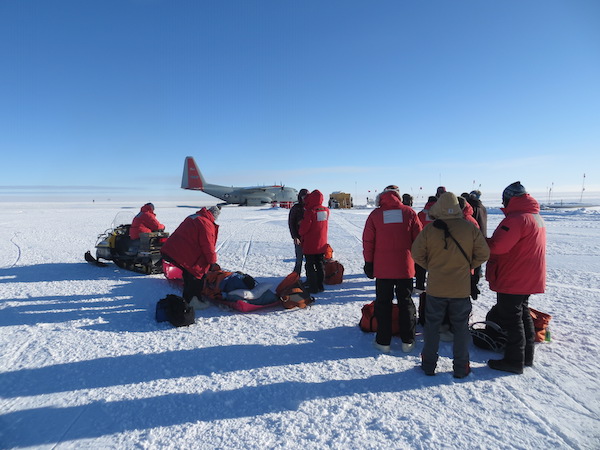 We wait for the go-ahead to board the Herc. That’s Jim laying on a sled, being pulled by the snowmobile. We got into McMurdo around 10 pm that night. By 10 am Wednesday morning I was on a Herc northbound for McMurdo, with Jim on board as well. On Thursday morning, I was departing Christchurch to begin the long journey back home to Madison, WI.
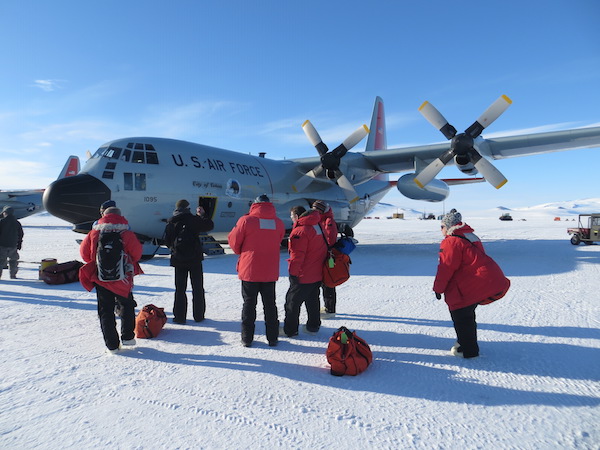 We’re back at McMurdo! And just like that, our portion of the field season concluded. We went from thinking we were going to be stranded at WAIS for Christmas to getting home in the blink of an eye. Overall, it was another exciting field season for me, with some really cool sites seen and some satisfying field work accomplished.
Lee and Carol should be getting to the ice between Christmas and New Year’s. I’ll let them take over from here.
Dec 14 – Monday
Mark and I were hoping to be flying off continent, back to Christchurch, and heading home today. Instead, we are still at WAIS. The weather and flight schedules have not cooperated with us, so our new off-ice departure date is now Thursday 17 December.
We made two more attempts to fly back to McMurdo, this time via Twin Otter instead of LC-130, on this past Saturday and Sunday. There are also 3 other people from WAIS who want to get back to McMurdo. Since the Otter is a smaller aircraft, it requires fuel stops along the way to McMurdo, whereas the LC-130 can make a non-stop flight. This has two implications: the Otter trip is a long one, and weather needs to be good at 4 locations instead of 2 (we were planning to stop at Byrd Camp to pick up a passenger along the way, then stop at Siple Dome Camp to refuel, then land in McMurdo).
On both days, the weather in West Antarctica (WAIS, Byrd Camp, Siple Dome Camp) was gorgeous: mostly clear skies and calm winds. Unfortunately, the weather was poor in McMurdo, with low clouds, fog, and low visibility.
On Saturday morning, Troy, the Otter pilot, decided that we wouldn’t be going to McMurdo due to the poor weather. Given the good weather in the region, including at the site of a new station install, Mark and I decided to take the opportunity. We installed Austin AWS. West Antarctica now has a new data point!
This was both mine and Mark’s first new station install. (I was along for the install of White Island AWS a few years ago, but the Rigger crew did most of the work with the guy wires because that station is on rock. Austin AWS is on snow.) We had one boondoggler with us, Catherine Dudley (WAIS medic), and she and the pilots were excellent helpers for the entire installation.
 We laid out the equipment and gear for the new installation. That’s Catherine on the right. (Photo credit: Mark) Here’s the order of operations for installing a new AWS:
0) Preassemble anything you can. The guy wires were attached to one tower section before we left; one extends from each of the three tower poles. The turnbuckles were also attached to the dead men prior to departure.
1) We asked Troy if he could use the plane to make ski marks in the snow that are oriented in the true North-South direction. He did this, as well as parked the Otter in said orientation. This is necessary for the proper installation of the anemometer, as one part of it needs to be pointed true South.
2) Connect the two tower sections (one 10 feet, one 7 feet) together on the ground.
3) Dig a hole, approximately 2 feet deep since we didn’t have a baseboard, into which we can put the tower.
4) Install as much instrumentation on the tower as is practical, while the tower is slightly lifted off the ground (we propped it up on a couple cases to make the installing easier). We installed the anemometer, Argos antenna, upper temperature, relative humidity, solar panel, enclosure, and lower temperature.
 With the main hole dug and the towers connected, we assembled all of the instrumentation, save the ADG and pyranometer boom. From left: Mark, Troy, John. (Photo credit: Catherine) 5) Lift up the tower into the hole. This took all 5 of us to accomplish.
6) Orient the tower to have one face point North-South. This makes aligning the anemometer that much easier. One done, fill in the hole.
7) Extend the guy wires out and determine where to bury the dead men. Then dig holes for the 3 dead men, approximately 4 feet deep.
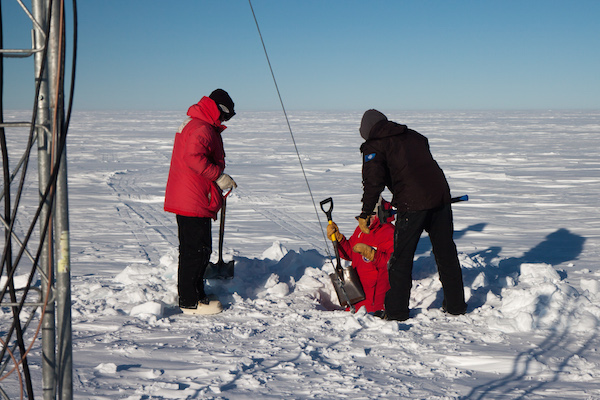 Digging a hole for one of the dead men. From left: me, Catherine, John. (Photo credit: Mark) 8) Attach the guy wires to the dead men, then bury the dead men in the holes, making sure the tower is level and plumb all the while.
9) Once everything is secure, the tower is secured and everything else can proceed as normal.
 A new AWS! A new data point in Antarctica! And as you may be able to tell, the visibility decreased drastically by the end of our visit as the winds had increased. (Photo credit: Mark) We felt pretty good after we completed this install. Any work that we can do now is less work that Lee and Carol need to worry about when they come to WAIS. While we have the Otter to ourselves, we might as well take advantage of it.
Yesterday, Sunday, we tried the same thing as Saturday in taking the Otter back to McMurdo. Once again, with great weather in West Antarctica, McMurdo was the limiting factor. We were on a weather hold until 10:30 am, when we got an updated weather forecast for the evening in McMurdo. It initially called for some clearing, so Troy decided that we should go for it. Everyone loaded all their gear on the Otter, and we took off at 11:45 am. Ten minutes in the air, we boomeranged. Troy had gotten an updated observation from McMurdo where fog was rolling into the region quickly. Troy made the call that rather than being forced to camp near McMurdo, we would go back to WAIS. It was the right call, but it was a bummer because we were so close to making our scheduled departure date but now need to push it back.
 Five people’s personal bags and sleep kits were stuffed into the Twin Otter. The consolation, once again, was that Mark and I were able to fly to another AWS, this time back to Evans Knoll AWS. We reinstalled the enclosure that we had removed a few days back, complete with a functioning pressure sensor, and installed a new solar panel.
We took 3 boondogglers with us: Kristen (chef), Anne (camp supervisor) and Kevin (mechanic). On our way to Evans Knoll, we took the scenic route and saw some amazing images of icebergs, islands, penguins and seals. Evans Knoll is near Pine Island Bay and Pine Island Glacier, an area where the ice is breaking up rapidly. Also, at Evans Knoll itself, the winds were very calm (sometimes at 0!) which was a huge improvement from the 30 knot winds we encountered on our first visit.
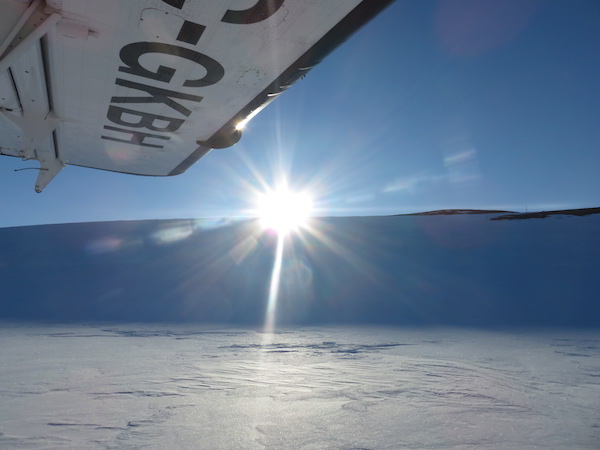 The sun was peaking over the hill we needed to climb to get to Evans Knoll AWS, on the right and at the crest of the hill. 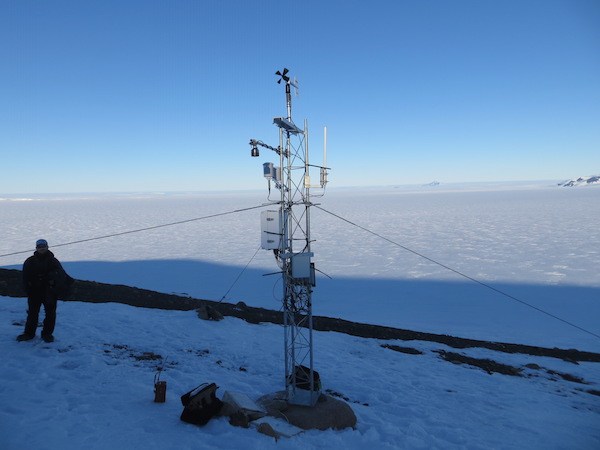 Evans Knoll AWS with the enclosure reinstalled and a new solar panel installed (on the opposite side of the tower). The latest on leaving WAIS is that our LC-130 flight (a backup mission) for today was cancelled because the primary mission went to Christchurch (no surprise there). I think we are on a primary mission for tomorrow, but we won’t find that out exactly until later tonight.
Dec 11 – Friday
The past few days have been busy ones for Mark and I. First, we have been on the flight schedule to leave WAIS on an LC-130 back to McMurdo on Wednesday night, Thursday night, and now tonight. We are still at WAIS because the plane couldn’t come Wednesday due to mechanical issues, nor could it come last night because of crew availability. It is scheduled to come tonight at 9:30 pm local time.
While we’ve been on the LC-130 schedule, we’ve also been on the Twin Otter here. It has been possible for us to still do field work because the LC-130 flights have been scheduled to arrive at WAIS around 7 pm or later.
On Wednesday, Mark and I flew with Paul Koubek (mountaineer) and Joel Gombiner (geologist) to Brianna AWS (to remove) and Erin AWS (to raise). Paul came with us because Brianna was installed near several crevasse fields. Joel came with because we had extra room and could use the extra hands for digging and other tasks in the field.
Brianna was installed in 1994 but had not been visited sine 2002 because pilots had not wanted to land among the crevasse fields. At the beginning of this field season, I spoke with Brad, from the Polar Geospatial Center, in McMurdo to get high-resolution satellite imagery of some of our more precariously located AWS, including Brianna. He was able to get me a couple images of Brianna, one with a 20-km range and one with a 2-km range. The 20 km image showed several crevasse fields, that honestly look pretty nasty, surrounding Brianna AWS. The 2 km image, however, did not show any evidence of crevasses. At WAIS, after discussing this with the pilots and with Paul, we decided that it should be safe enough to land right next to the AWS and not have to worry about crevasses (Twin Otter planes are able to land in a very short distance).
 A crevasse field as we neared Brianna AWS. We landed at Brianna AWS without any problems and got right to digging out the station. With everyone, including the pilots, helping to dig, we were able to remove all the instrumentation, a battery box, and the top tower section in just over an hour. This gave us plenty of time to go to Erin AWS.
 Brianna AWS when we arrived. It’s short, but after almost 14 years since its last visit, it’s not too bad! 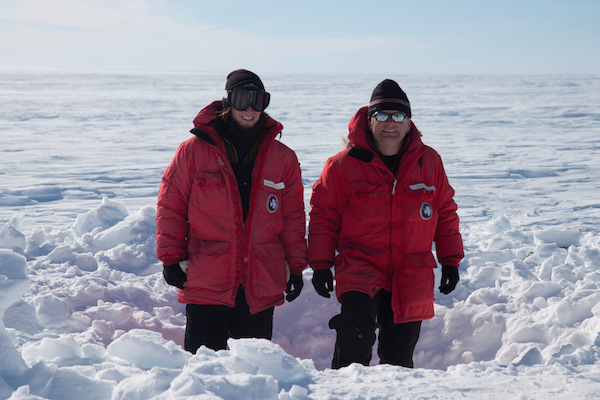 We removed (almost) all trace of Brianna. And when given an opportunity to have a picture taken of you standing in a hole, you take it. At Erin, which has a gorgeous view of the Transantarctic Mountains, we noticed that the station did not need to be raised. It was plenty tall, so all we needed to do there was raise the enclosure.
 Erin AWS, after we raised the enclosure. The Transantarctic Mountains can be seen on the horizon. On Thursday we flew by Twin Otter to Evans Knoll AWS. Our goal for this visit was to fix the anemometer and pressure sensor, both of which weren’t transmitting. We had tried to visit this site about a week earlier but were unable to land due to flat light. This time, it was nice and sunny when we landed. The wind, however, was roaring. It was a sustained 25 to 30 knots! We needed to climb up a fairly steep hill to get to the AWS, and the wind made it that much more difficult. At least it was a balmy 30 degrees F.
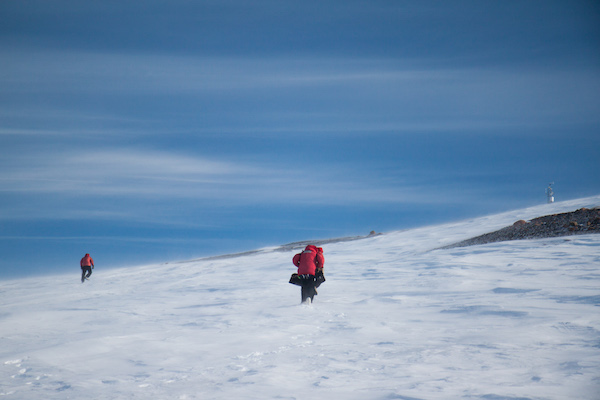 It was a fairly steep walk from the Twin Otter up to the AWS. That coupled with the winds made it very tiring, as Paul (left) and I realized. 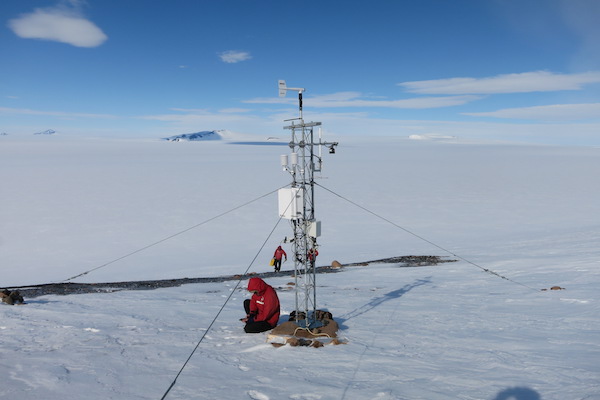 Evans Knoll AWS when we arrived. The anemometer was a simple fix; the nose cone and propeller were missing due to the very high winds. We were unable to fix the pressure sensor on site. One unexpected thing we noticed was that the solar panel was missing too! The high winds must have rattled it loose and flung it off its mount. Without the solar panel, the batteries can’t get charged and will eventually drain. Given this, and that we couldn’t fix the pressure sensor in the field, we decided to power down the station and remove the electronics to bring back with us. This way we can diagnose any issues with the pressure sense in the lab, get a solar panel ready to install, and put everything back at Evans Knoll (hopefully later this field season) without draining the batteries. Because it would not be fun carrying 150 pounds of batteries up that hill!
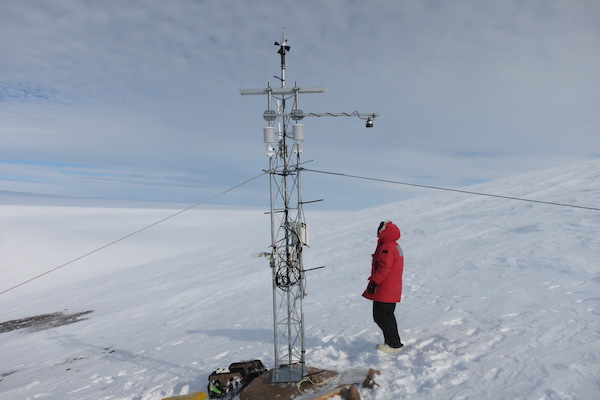 Evans Knoll AWS after we replaced the nose cone and propeller, and removed the enclosure. We were flying back to WAIS when we heard the unfortunate news that our LC-130 flight had been cancelled. It was especially unfortunate because when we got back to WAIS, the weather was gorgeous. Mostly clear skies, low winds, great visibility, and all-around perfect for an aircraft to land.
Today, Friday 11 December, the weather isn’t as good. It’s been pretty windy (~15 knots) all day, with low visibility in blowing snow. Hopefully by tonight the winds will die down so the plane can take us back to McMurdo. After all, we’re scheduled to leave the ice on Monday, 14 December!
Dec 8 – Tuesday
This past Sunday, into early Monday morning, a strong storm came through WAIS. This storm consisted mostly of high winds and blowing snow. Winds were sustained at around 25 to 30 knots (I think – this is just my guess as I don’t have the official numbers). During this time, snow drifts accumulated and grew between the tents. Pictures, and videos, really tell the whole story, and I wish I could send those along real-time, but I’ll be sure to include them once I am able to.
Visibility decreased to around 300 feet at times, leading to “Condition 2” weather. I spoke with one of the weather observers here, and she said that while she didn’t observe Condition 1 weather when she made her few weather observations, she said that most likely Condition 1 weather did occur at times. This meant that visibility got down to lower than 100 feet! This is testament to how high the winds were and much blowing snow there was.
For much of the day on Sunday, people in the camp were either hanging out in the Galley tent or the Rec tent. We either watched movies or played board games all day. There really wasn’t much else to do!
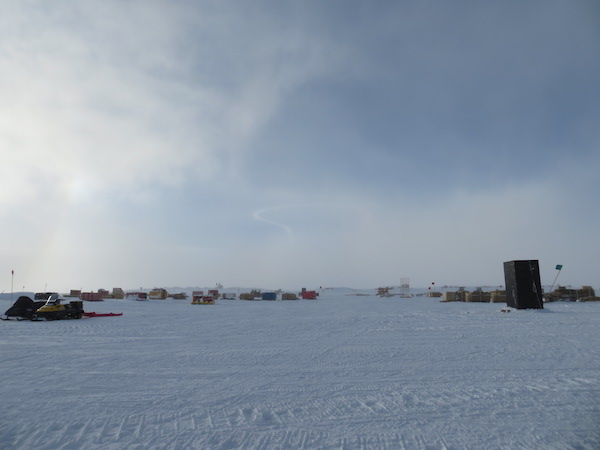 Here is a view from outside our tent on a normal evening, sans storm.  Taken by Mark, this is a similar view as in the picture above, but during the strongest parts of the storm. Visibility was extremely low! It was very difficult to sleep in our tent on Sunday night. The winds were whipping the tent, and at times I was worried the tent would get picked up and blown away! Of course, we have the spoiled science tent to sleep in, which is large, heated and well secured to the ground. I couldn’t imagine sleeping in a single-person mountain tent during those winds. Then I would have really been worried about blowing away.
By 7 am on Monday, the winds had died down and the blowing snow had tamed. Skies cleared, and it turned out to be a very nice day. One impact of the blowing snow is that the topography of the camp becomes very uneven, so the camp crew needs to bull doze the snow drifts down and groom the surface so it’s even and easily to travel on. The ski-way, where the planes take off and land, also needs to be groomed so planes, such as the LC-130 and the Twin Otter, can use it safely. If the ski-way isn’t well groomed, a pilot may fly over it and decide that it doesn’t look safe enough to land and they will choose not to. Grooming the ski-way is very important. That Monday morning, crews got to work right after breakfast to make the camp and ski-way safe for travel again. It’s impressive to see how quickly and methodically they do this work. Everyone knows their role, and by the end of the day the camp looked like it did on Saturday, before the storm.
 A drift that developed from the storm between the science tents. The dozier had already begun flattening the drifts around camp. Meanwhile, Mark and I haven’t flown since we went to Thurston Island. When the weather has been good at WAIS, it was poor everywhere else. And of course when there’s a storm at WAIS pretty much everything is at a standstill. Today is no exception, as the weather is good here but a no-go at all other sites. Mark and I are planning to leave WAIS to go back to McMurdo tomorrow night, Wednesday 09 December. Given we wouldn’t be leaving until the night, we may be able to have one more chance to fly during the day. There’s talk of some high winds coming this afternoon and remaining until Wednesday morning, so we will see how that affects our plans.
Dec 4 – Friday
On our third full day at WAIS, Mark and I flew for the second day in a row, this time to Thurston Island AWS. Our plan was to go to both Evans Knoll AWS and Thurston Island AWS, and when going over the weather with the Otter crew before departure, it looked like Evans Knoll had better weather than Thurston Island. We decided to check Evans Knoll first.
With us came John Stone, the aforementioned geologist, and Paul Koubek, a mountaineer. Paul came along because these AWS are on islands covered in ice, and with that comes crevassing as the ice spreads down the slopes of the islands. We wanted to take the extra precaution and have an expert with us to make sure we didn’t walk into a crevasse field. Spoiler alert: We didn’t encounter any crevasses while walking!
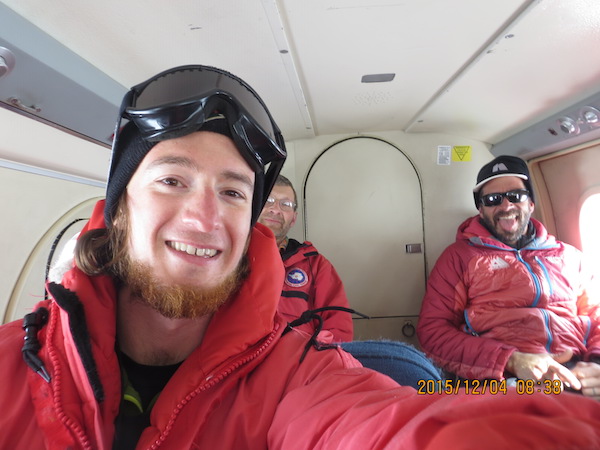 John Stone and Paul Koubek are in the background. As we approached Evans Knoll, cloud cover dominated the area. This led to “flat light” in which the surface features and definitions are very difficult to discern. This made it unsafe for us to land, as the pilots could not distinguish the slopes of the island and therefore find a safe place to land. After circling the island several times they decided we shouldn’t land, so we headed to Thurston Island.
I had it in my head that the weather at Thurston would be similar to Evans Knoll, and we would shortly be heading back to WAIS. I’m very glad that I was mistaken; it was mostly sunny at Thurston, and we circled the island a couple times and then went in for a landing. We taxied close to the nunatak (area of exposed rock in an ice field) where our AWS is located, then Paul got out and checked the surface to make sure it was safe. Sure enough, it was, so we lugged our equipment up the small hill.
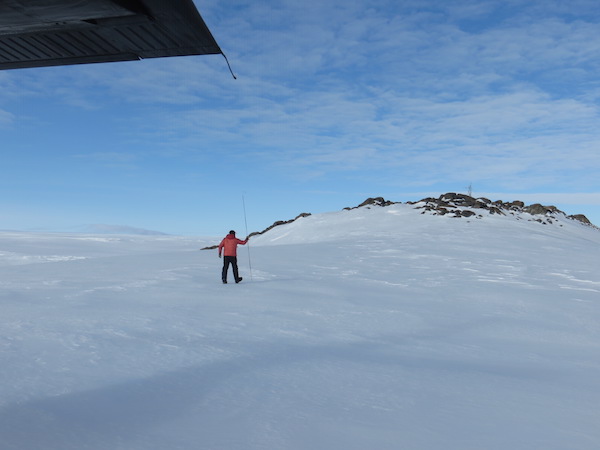 Paul checked for crevasses along the path from the plane to the AWS (upper right). I was not expecting this sight to be as pretty as it was. For starters, the weather was pleasant: temperatures around 20 F and light and variable winds, with sunny skies. Also, being on the highest point of the island (I think) allowed for great views of the area. Setting aside the picturesque scene, Mark and I got to work repairing the station. This site experiences very high winds on occasion (luckily not today!), and because of that the wind monitor and the relative humidity sensor were damaged.
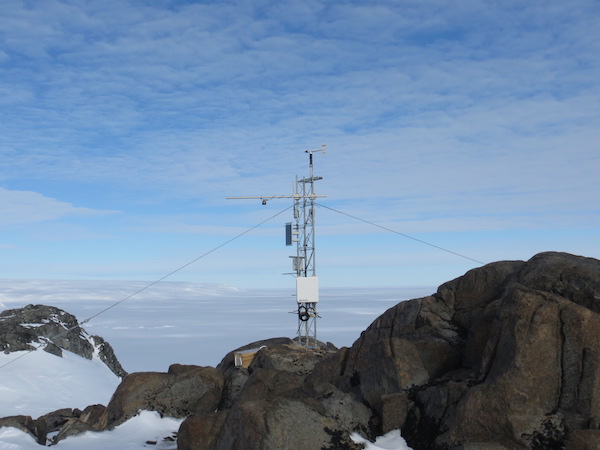 Thurston Island AWS upon arrival. I climbed the tower to replace the nose cone and propeller on the wind monitor. We then removed the old relative humidity sensor and installed a new one. After adjusting the program on the data logger to accommodate the new RH sensor and verifying all data output looked good, we called our work complete and got ready to leave.
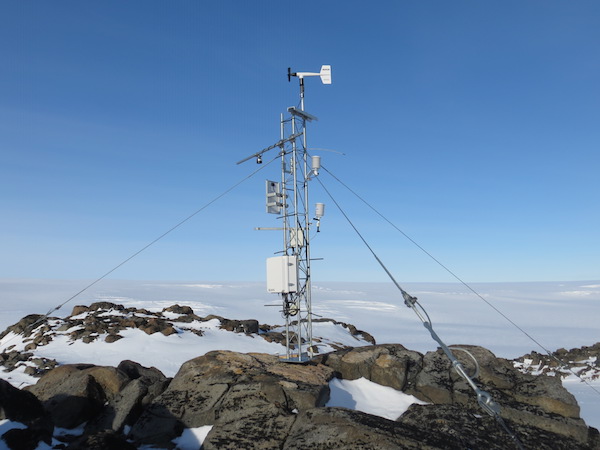 Thurston Island AWS after our work was complete. While Mark and I were working on our AWS, John and Paul were walking around the exposed rock regions, and John collected some rock samples. We were happy to have John come along and get some use out of this trip!
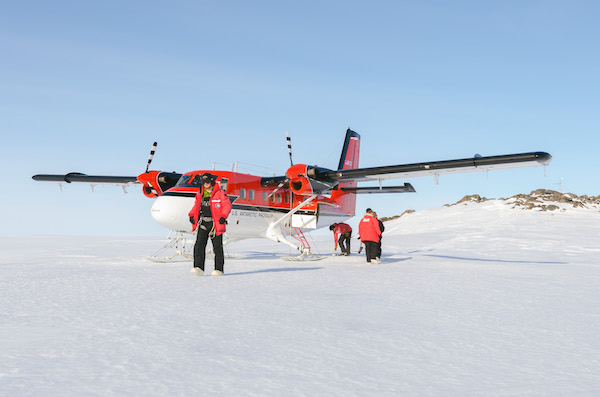 John Stone took this picture of us as we were getting ready to leave. Note how you can see the AWS on the right. Our flight back to WAIS was a lengthy one: 467 nautical miles, to be exact. It took us about 3.5 hours, and it was the longest Twin Otter flight I had been on. We were also flying relatively high up (~16,000 feet). At this elevation, the lack of oxygen is noticeable. Mark asked the pilots about this after we landed, and they said they flew so high to catch the tail winds and get good fuel efficiency so we wouldn’t have to stop at a fuel cache on the way back to WAIS. No complaints on my end! I was able to read a couple chapters in my book and doze off a couple times. All in all, it was a good day for AWS fieldwork.
Dec 3 – Thursday
Mark and I had our first station visit out of WAIS today, Thursday 3 December, going to Byrd AWS to raise the station.
We hadn’t planned on going to Byrd. In our first scheduling meeting with the Twin Otter pilots, we told them we wanted to aim to go to four AWS for our first two flights: Thurston Island and Evans Knoll for one flight, and Erin and Brianna for another flight. The other science group, John and Joel the geologists, are also hoping to use the Otter to put in their camp at Parrit Hills. Today, the weather was poor at all of the listed locations, so we thought there wasn’t going to be any flying.
Mark had the great idea to ask if the Otter pilots, Troy and John, if we could try going to Byrd AWS. It is located near WAIS (only about a 40 minute flight away), and it’s collocated with Byrd Camp, where 4 people are currently staying, trying to dig out the camp. They would be able to provide ground weather observations for us, ensuring it would be safe to fly.
Lo and behold, the weather was excellent at Byrd, and we got the go ahead to fly there! We started getting our equipment ready, and some WAIS camp staff gathered up some boxes of supplies to send to the Byrd Camp staff, including mail.
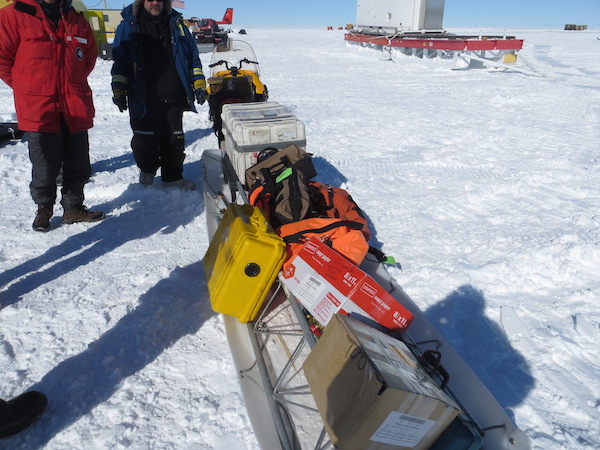 We used a snowmobile to bring most of our cargo over to the Twin Otter before departing. We departed WAIS around 9:30 am and got to Byrd camp around 10 am so we could first drop off the extra supplies. The Byrdies (I’ve decided to call them that… I haven’t heard anyone else refer to them as such) were really excited to see us, and even more excited to get their presents. I recognized them from when we were in McMurdo, as they were waiting for their chance to get to Byrd Camp.
Once we all exchanged pleasantries and said bye to the Byrdies, we taxied in the Otter over to Byrd AWS. It is within eyeshot of Byrd Camp.
The station raise went very smoothly. There were hardly any hiccups. Troy and John were very kind to help us with digging, handing up instruments and/or tools, and making the work proceed efficiently. The station now stands pretty tall and won’t be getting buried any time soon!
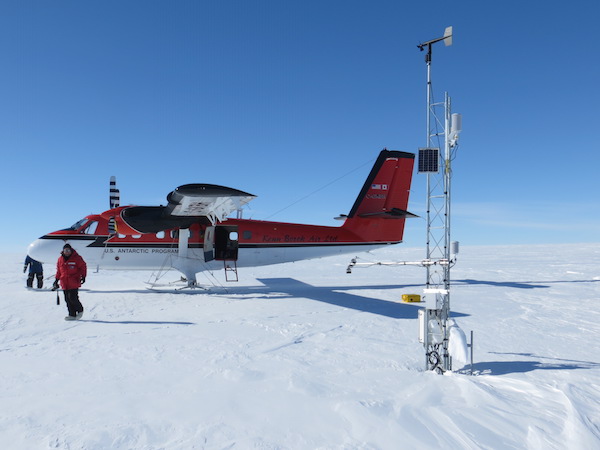 Byrd AWS before the raise. 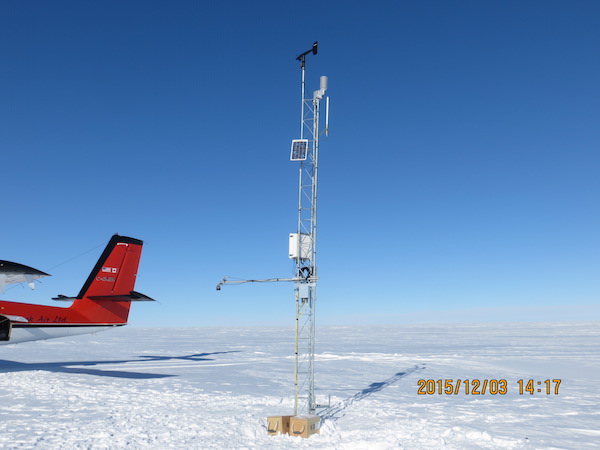 Byrd AWS after the raise. We had a very good first experience with doing AWS work out of WAIS, and we’re only on our second full day here. Hopefully there are more days like this to come during our (planned) short stay at WAIS!
For the cargo update, on the night of December 2 we got our case of the rest of our equipment, including radios and harnesses. Now all we’re waiting on are the extra power systems and tower sections for the station installs and replacements. Those might be coming tonight!
Dec 1 – Tuesday
We arrived at WAIS today! Just in the nick of time, as we had set this day as our cut-off date to get out to WAIS. If we didn’t make it today, we figured it wouldn’t be worth our time to leave McMurdo to come to WAIS, given our off-ice departure date is 14 December. There was still plenty of work that we could have done in McMurdo, but now that we were able to get to WAIS, hopefully weather will cooperate and we can knock off some station visits here!
Mark and I left McMurdo at 8:15 am, boarding an LC-130, WAIS-bound. Overall, it was a pretty uneventful flight and we reached WAIS at 11:50 am. It was a little windy when we got off the plane but not too windy, and temperatures were around -4F. There were 5 passengers total on this flight: myself, Mark, Paul (mountaineer), and John and Joel from another science project. The rest of the flight weight was taken up by cargo. I think there was approximately 12,000 pounds of cargo allowed in the plane, so you can get an idea of how much cargo was on the plane! This included 2 snowmobiles for John and Joel.
 The LC-130 at WAIS, after we departed the plane. We got off the plane, took our hand-carry bags and first went to the galley where we were told to meet. We were greeted by people who were anxious to get on the plane back to McMurdo. They had been waiting at WAIS for this flight for almost a week, and I could tell that they were ready to go. I’m glad they were finally able to get out!
Eventually we got our in-brief and got acquainted with the camp. The camp is essentially organized in lines. If looking at the camp from a bird’s eye view, the lines are oriented vertically. The furthest left line is made up of work tents; this includes the galley and wash module, the medical tent, two science tents, the mechanical tent, the Twin Otter and fuel station and a couple others. All of the work tents are heated. At the bottom of this line is “tent city,” where each WAIS resident has their own tent to sleep in. The next line to the right is the line of outhouses, to go to the bathroom. The remaining 4 lines to the right are cargo lines.
 Aerial view of WAIS camp, taken from a Twin Otter.  An annotated aerial view of WAIS camp. Mark and I are in one of the two science tents, and we have it to ourselves for the time that we will be at WAIS. There is plenty of space in the tent to allow for a few tables, used as desks for Mark and I and as a work bench, and even enough space for cots. Beth, the camp manager, offered that Mark and I could sleep in our work tent instead of setting up a tent. We decided to take her up on the offer. I know we’re not getting the “full” field camp experience, but since we only plan to be here for a little over week, we thought we might as well sleep in a heated tent on cots. Honestly, it’s quite luxurious.
We’re getting things set up already, and even though we don’t have all of our cargo here (it’s a long story), we do have enough to do work on a couple AWS right now. We plan to leave WAIS between December 8 and 10, so hopefully our cargo can come soon so we can do as much work as possible while we’re here!
Well that’s all for now. I’ll be writing more updates as they come.
The weather was great for a station raise at Elaine. For the entirety of our visit, the winds remained low and temperatures were around 10F.
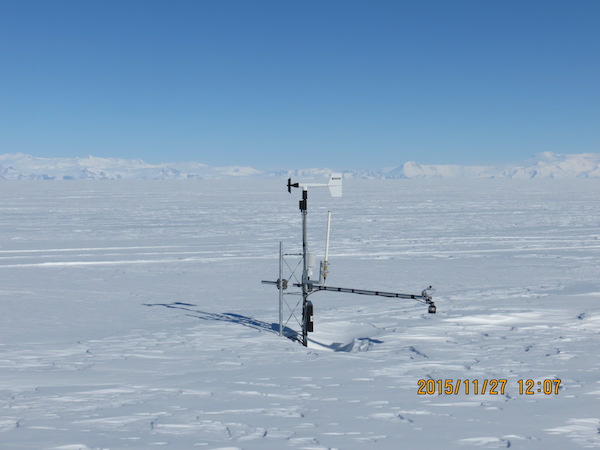 Elaine AWS when we arrived. There was a lot of digging in store for us. In the background are the Transantarctic Mountains. As the picture shows, Elaine obviously needed to be raised. There had also been an issue with the relative humidity sensor, which manifested itself as unusually steady observations. I’m willing to bet the reason for that problem was because the sensor was buried!
Mark and I had to dig down about 6 feet to get to the enclosure and free up all of the cables that we needed to loosen so we could raise the instrumentation on the new tower. The work was fairly slow-going, but the pilots were nice enough to help us out with some digging when they could.
After several hours, we had Elaine raised up and featuring a new relative humidity sensor. We took some pictures and then headed back to McMurdo. Not too shabby, considering we thought we were flying to WAIS early in the morning!
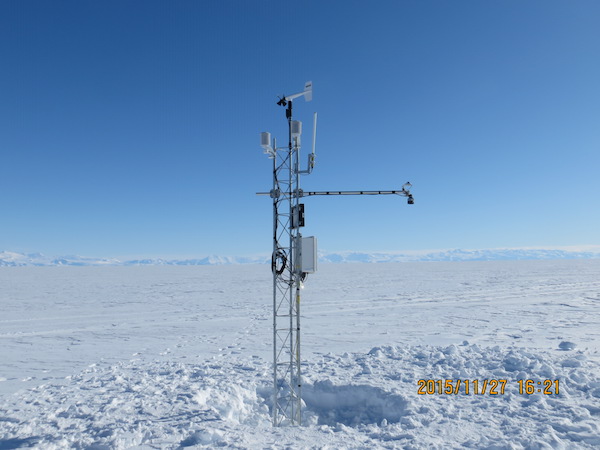 A taller Elaine AWS.
Mark and I remain in McMurdo for the Thanksgiving holiday weekend. On Thursday, our flight to WAIS boomeranged! We left McMurdo around 10 am, but when we reached WAIS, the weather was too poor to land. Our plane circled the camp for about 20 minutes, but eventually the pilots received word from people at the camp that the visibility was too low for our plane to land. We had to turn back and go to McMurdo.
Yesterday, we were again on the schedule to go to WAIS, but our flight was cancelled due to poor weather at WAIS.
This is a common theme for WAIS: poor weather and long delays.
While people worked in McMurdo on Thursday, Thanksgiving day, the town is pretty much closed for business this Saturday and Sunday. (Almost) everyone has these two days off, including the pilots. If there’s good weather at WAIS, we can’t take advantage of it this weekend. At least Mark and I can enjoy the Thanksgiving festivities in town!
We will surely be trying again on Monday. I’ll update you all when I can!
Earlier this week, on Monday 23 November, Mark and I took a helo “night flight” to Linda AWS to finish up the work we couldn’t get done during our first visit there 9 days prior. The helo schedule has been fairly busy as of late, so the best time that they could squeeze our flight in was at 7:30 pm that Monday night. Normally our helo flights don’t go much past 5 pm.
The night flights are much more relaxed than flying during the day. There are fewer flights to be done and fewer helo personnel. Mark and I took an A-Star (smaller of the two helos) and flew to Linda AWS to check the pressure sensor, swap it if need be, install the new power system, and raise the enclosure on the tower.
When we arrived, we noticed that the hole that we made when we tried removing the power system in our first visit was completely filled in. Those strong winds created enough blowing snow to fill the hole, as if we have never tried. Luckily, the weather was much more pleasant this go-around. Temperatures were around 15F and winds didn’t get much above 10 mph. It’s so much easier to do field work when it isn’t windy!
 Linda AWS when we arrived. The old power system is buried to the right of the station; the new one is visible. Our first order of business was to check the Paroscientific pressure sensor because it was not reporting any values. We checked connections and did some diagnostics but could not correct the issue. We had to swap out the existing one for a Vaisala pressure sensor. We were able to get measurements to transmit with the Vaisala, so we plan to do some troubleshooting back in Madison with the seemingly faulty Paroscientific pressure sensor.
We dug out the existing power system, with the help of the helo pilot and connected the new one. Lastly we raised the enclosure, which involved reorganizing the long cables extending from the sensors on the tower. This, admittedly, took a little longer than expected. In the end, we finished our work at Linda and can check this AWS off the list for this field season.
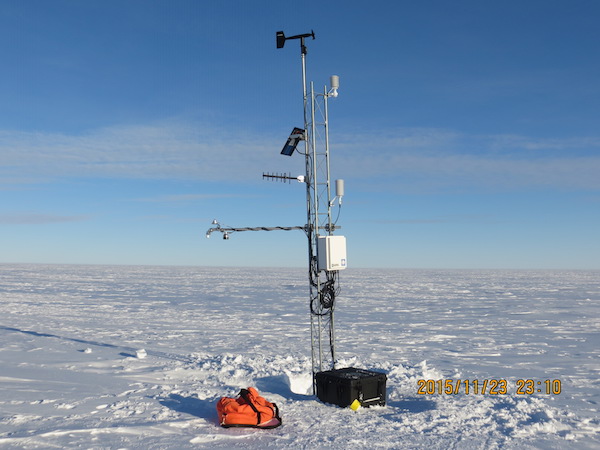 Linda AWS when our work was completed. In other news, Mark and I are on the schedule to go to WAIS tomorrow, Thursday 26 November (Thanksgiving). This departure date has changed many times, as weather and scheduling dictates. As I’m writing this, just a couple hours ago we thought we were going to depart on Friday, but we got an update saying the plan is to leave tomorrow.
We plan to be at WAIS until approximately December 10. While there, our internet availability will be limited to email, at best. As such, I will not be able to update you all with our work, real-time. I will be writing up equivalents to blog posts while we’re out there, so when we get back to McMurdo I can post those and you all can catch up on our adventures.
Cheers for now!
|
|






































